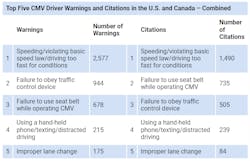Industry stakeholders have high hopes for roadway safety in 2023
As the nation exits a busy holiday season filled with high travel volumes, meaning more traffic and more risk, trucking stakeholders, safety regulators, and technology companies alike are working hard to ensure that 2023 is a safer year for everyone on the road.
Overall safety trends have been worsening for years. According to the latest data from the National Highway Traffic Safety Administration (NHTSA), traffic deaths reached a 16-year high in 2021. From Jan. 1 to Sept. 30, 2021, NHTSA measured over 3,700 fatalities in crashes involving at least one large truck—a 13% increase from 2020.
“I don’t think that’s going to change any time soon,” said Heidi Simon, program manager of mobility safety strategy at the National Safety Council, a nonprofit safety advocacy organization. “The pandemic exacerbated a lot of things we’ve been dealing with for decades."
“Driving, in general, is still getting worse,” Stefan Heck, CEO of vehicle safety platform provider Nauto, told FleetOwner. “We're seeing increases in collision rates. We're seeing increases in damage from those collisions. … The pandemic did not help. It changed some of the mix of different kinds of collisions, but it overall made things worse.”
See also: Truck crashes happen. Then what?
In 2021, fatalities in speeding-related crashes were up 5% from the previous year, according to NHTSA. The Commercial Vehicle Safety Alliance (CVSA), as part of its Operation Safe Driver Week awareness campaign, which took place from July 10-16, 2022, issued 36,164 warnings and citations combined for unsafe driving behavior in the U.S. and Canada between both commercial and passenger vehicles. Speeding was the most common violation. According to the American Transportation Research Institute's “Predicting Truck Crash Involvement” report, speeding increases the likelihood of a crash by 47%.
Potential safety infrastructure improvements in 2023 and beyond
Simon did indicate, however, that there are signs things could improve, if even slightly, in the long term. Recent years have seen increased infrastructure investment from the Department of Transportation, as well as from local and state governments. She also said she had high hopes for the Infrastructure Investment and Jobs Act, calling the funding package “historic.” And as small as the victory may be, NHTSA recorded the first decline in traffic deaths after seven consecutive quarters of increases.
Heidi underscored the need for safety to be a discussion prioritized at federal, state, and local levels. One example of national agenda-setting is the DOT’s National Roadway Safety Strategy. Released in January 2022, the strategy outlines a multi-pronged approach to reducing fatalities and injuries. It reasons that by focusing on multiple variables, including driver behavior, vehicle design, and roadway design, human error can be accounted for, reducing the likelihood of death or serious injury in the inevitable occurrence of a crash.
ADAS, AI, and the search for better road safety technology
Commercial vehicle safety has made strides in recent years with advanced driver assistance systems (ADAS) and other technologies. NHTSA published the results of a study on automatic emergency braking (AEB) in November 2022, indicating that vehicles equipped with AEB and forward-collision warning reduced crash frequency by approximately half. ADAS technology is continuing to be refined, with many improvements due to advances in artificial intelligence.
“AI is definitely the biggest safety tool in driving since the invention of the seatbelt,” stated Nauto's Heck. Artificial intelligence, such as the AI in Nauto’s safety platform and dashcams, Heck said, can detect high-risk scenarios, such as imminent collisions or distracted driving, alerting drivers and allowing them to self-correct before a crash occurs.
See also: Deterring distracted driving to save dollars and lives
Driver-facing cameras are still resisted by many drivers, and ATRI is still investigating their safety impact. However, the Federal Motor Carrier Safety Administration produced a video in which it estimated 63,000 crashes could be avoided if video systems, including driver-facing dashcams, were widely adopted.
Heck also maintained that AI platforms offer increased privacy over traditional dashcams that merely record video. Heck said the supervisor could not drop in and watch a stream of dashcam footage, and whether a fleet wants a video recorded in case of a collision or other event is optional. This, Heck said, results in higher acceptance from unionized fleets.
“AI, like any technology, comes in many different flavors,” Heck said, “so just because a dash camera has AI on the box doesn’t really mean anything per se. You’ve got to ask, what does it see, what does it cover?”
See also: ‘Nuclear’ verdicts roil and rile trucking
Distracted driving, for example, can be detected. Measuring collision data from the 800 fleets that use Nauto technology, Heck said distracted driving is a factor in about two-thirds of cases, and the company is further developing approaches to improve that. Approximately 60% of financial losses from collisions are related to distraction—the vast majority of that, Heck said, being related to an electronic device such as a smartphone or a tablet used for GPS.
But there are other scenarios that are more difficult for the AI to mitigate, Heck said. Fifteen percent of total crashes are high-speed head-on collisions, which the AI is not always able to detect in time to avoid. Sideswiping is also hard for Ais to prevent, he said.
Despite public perception of commercial vehicles being more dangerous, passenger car drivers are responsible for over 70% of crashes between commercial vehicles and cars, according to ATRI SVP Dan Murray, who cited studies from Federal Highway Administration in the U.S. and Transport Canada during 2022’s American Trucking Associations’ Management Conference & Exhibition. Of possible comfort to truckers and carriers is the fact that more automakers are making AEB a standard feature on passenger vehicles. Additionally, Heck told FleetOwner that Nauto is working with one manufacturer to integrate their technology into the company’s cars by 2026, though he said that he couldn’t reveal which manufacturer. He noted that the biggest technological hurdle manufacturers have for integrated AI safety technology is having enough network bandwidth to transmit over-the-air updates to vehicles.
About the Author
Scott Keith
Scott Keith is a former fleet owner digital editor, who was on staff from 2022 to 2023.


